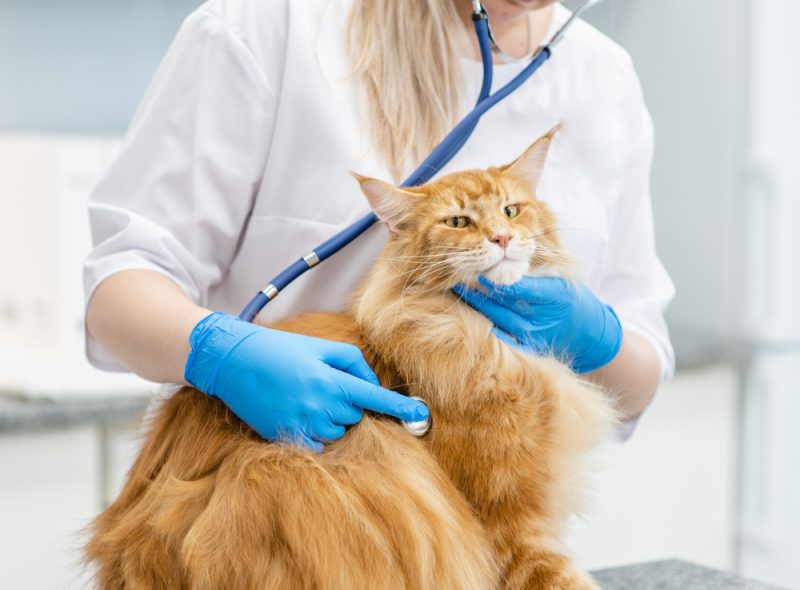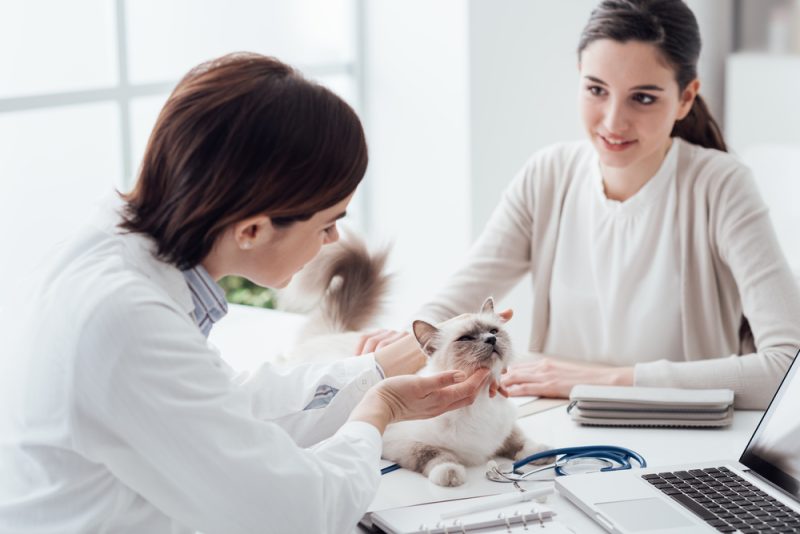Vet visits have always been instrumental in promoting our pets’ health and longevity. But for most cats, the experience can be more stressful than anything. The strange setting and unwanted interactions with unfamiliar people make a perfect formula for anxiety, leading to aggression in many instances. Vets often can’t administer tests or treatments with uncooperative pets, making the experience frustrating and unfulfilling for the animal, the owner, and the veterinary staff.
Fear, anxiety, and stress (FAS) at the vet have come into the spotlight in recent decades, spurring the Fear Free movement. Fear Free is an organized effort to educate experts and owners looking to make vet visits more accommodating and calming so pets can get the care needed to thrive. Discover what Fear-free vets are and what they can offer to make your anxious cat remain calm and have more productive trips to the vet.


How Does Fear-Free Veterinary Medicine Work?
Fear Free focuses on the anxiety pets often suffer at the vet. It supports veterinarians, vet staff, and owners with resources to make the clinical experience less stressful and frightening. Collaborations of companion-animal vets, behaviorists, veterinary specialists, trainers, and other animal experts create courses and certification programs to keep professionals and clients updated on best practices. The goal is to reduce stress and optimize the care cats and other pets receive.
Veterinarians can become Fear Free-certified by registering for certification programs on the Fear Free website. Individuals and multi-member practices can sign up for certification. Fear Free separates programs for general vet professionals, avian specialists, and equine specialists.
Fear Free can help reduce anxiety for pets in any stressful situation, including non-clinical settings. Certification is available for trainers, groomers, pet sitters, and boarding and daycare facilities. Even owners and shelter staff can gain support from Fear Free. A growing collection of free articles, guides, podcasts, and videos show them how to keep their cats happy, healthy, and safe.

What Do Fear-Free Vets Do?
Fear-free vets adapt their processes to suit each patient’s unique needs. The following are some of the methods Fear Free practices may use to help cats relax during their visit:
- Acclimating cats to the office environment before performing exams or treatments
- Monitoring for signs of fear and stress and adjusting their methods accordingly
- Providing toys, treats, petting, and other rewards to make the experience positive
- Offering separate rooms for cats experiencing stress in the waiting room
- Creating separate waiting areas for different animals
- Using calm, soothing tones of voice
- Minimizing ambient noises and stimulating scents
- Employing touch gradient to reduce FAS during physical contact
- Using atmospheric calming aids, such as pheromone diffusers, light dimmers, and music
- Educating owners on preparing cats for vet visits
- Applying mild sedatives or anti-anxiety medicines to ease anxiety when using restraints
How to Get Fear-Free Certification
Fear-Free certification entails a one-time signup fee for everyone receiving the training. After purchasing the membership, members complete certification programs consisting of several modules. They must also take online assessments and complete a virtual visit to see Fear-Free practices in action. By completing an extra 35 hours of CE (continuing education), professionals can earn an “Elite” status to showcase their commitment to advanced education.
Membership requires annual renewal, which comes with a fee. To maintain a Fear-Free certification, vets must complete 4 hours of Fear-Free CE annually.
Fear-Free members enjoy access to all certification programs. They can check out other CE courses and an expansive resource library of articles, podcasts, and webinars to stay updated on best practices. Additionally, Fear Free offers marketing materials and a toolbox. Vets can use these in their practices to advertise and implement their training. Members also earn a spot in the directory, helping them gain more clients looking for low-stress vet options.

Why Is Fear-Free Important?
Fear Free began in 2016 when “America’s Veterinarian,” Dr. Marty Becker, sought to expand awareness of FAS and how pet professionals and owners can take action. Most cats experience some anxiety at the vet. A German study found over 88% of cats showed stress signs, while roughly 50% of owners likewise felt stress, often stemming from their pets’ anxiety.1
Cats have shown a white-coat effect similar to humans entering a doctor’s office.2 Blood pressure rises as cats feel stress from the clinical environment. While this may decrease with time, the effect often doesn’t disappear entirely.
Vet visits are stressful for many animals. The “fight or flight” response is an inherent survival trait cats can display when they feel pain or illness and must interact with a stranger in an uncomfortable environment. Poor experiences can make future visits more challenging as cats associate each step with stress, starting with getting in the carrier at home.
Overly anxious pets complicate routine exams and other procedures by being agitated and uncooperative. Many cats become aggressive, putting workers in harm’s way and limiting the quality of care. In some cases, more involved procedures are often challenging due to the reduced efficacy of sedation and anesthesia associated with stressed animals.
The challenges stress creates can make owners less likely to seek medical care. Over a quarter of cat owners limit their vet visits because they cause too much anxiety for their pets.3 By implementing Fear-free practices, veterinarians can create a calmer environment and offer more thorough and effective care. Clients subsequently gain more confidence in bringing their pets in for checkups.
Where Is It Used?
Since Fear Free began, thousands of professionals worldwide have taken advantage of its teachings. With programs for virtually any pet professional, Fear Free offers owners the chance to seek out groomers, dog walkers, pet sitters, and boarding facilities that use Fear Free techniques, ensuring the highest quality care wherever their cats go.

Advantages of Fear-Free Vets
Fear Free empowers owners to give their cats the care they deserve regardless of their anxiety issues. Trained vets prioritize emotional and mental health by considering how they should assess and handle stressors. They monitor the pet’s body language, responding with grace and patience to ease stress as it appears and never forcing procedures on an unreceptive animal.
Fear Free practices offer numerous benefits for pets, owners, and vet staff, including:
- Fewer stress-related physical effects, allowing for more accurate diagnostics, more effective care, and faster healing and recovery
- Better emotional associations with going to the vet, making future visits smoother and faster
- Improved safety and fewer injuries due to cat aggression
- Greater compliance with routine care visits
- Shorter, more productive visits, saving owners time and money
- Higher job satisfaction for veterinary team members
- Better bonds between owners and their cats
Disadvantages of Fear-Free Vets
The primary drawback to the Fear Free certification program is the cost. Upfront costs for certification run a couple of hundred dollars, and annual dues are needed to maintain membership. Some criticize it for pushing training that uncertified vets may already apply for. To them, Fear Free can seem like an unfair advantage reserved for those willing and able to spend money on the certification.


Frequently Asked Questions
How Is Fear Free Beneficial for the Veterinarian?
Fear-free certification supports success. By applying Fear-Free principles, vets can improve client experiences, build return business, and increase customer scores. The certification also helps with marketing, allowing vets to attract clients with anxiety-prone cats.
Meanwhile, the staff enjoys more efficient and positive client interactions. With burnout a growing industry concern, the reduced conflict that comes with Fear-Free philosophies can make veterinary work feel less stressful and more fulfilling for everyone in the clinic.

How Can Owners Assist Fear-Free Vets?
Owners can start the process of calming their pets before they bring them to a Fear-Free clinic. While your vet can offer advice to manage your cat’s particular FAS struggles, the following are a few helpful steps to prepare your pet:
- Provide soft, comfortable bedding in the cat carrier
- Use pleasing scents and fun toys to comfort your cat in the carrier
- Acclimate your cat to the carrier before taking them on a trip by letting them explore it and giving treats for using it
Contact your vet to discuss your cat’s stress before visiting a Fear Free clinic so they can plan and prepare for your pet’s needs. Clients can set their cats and the clinic for an efficient, more productive visit with these at-home steps.


Conclusion
The Fear-Free initiative centers on building trust and showing respect to pets as unique individuals with feelings that deserve recognition. Cats may enter the clinic stressed, but they’ll exit feeling calm, confident, and ready for their next appointment. Certified vets and animal experts provide critical peace of mind to owners, ensuring their pets get the care they need without sacrificing their mental or emotional well-being.
Featured Image Credit: Prostock-studio, Shutterstock

